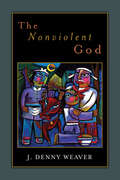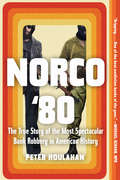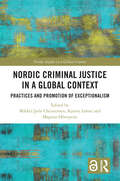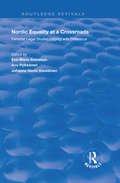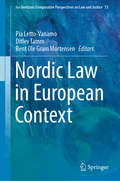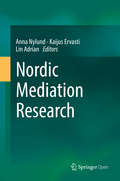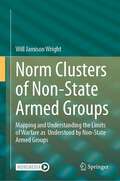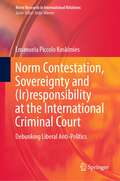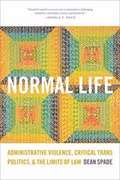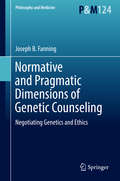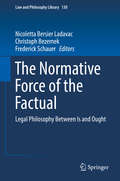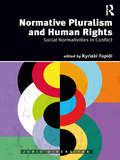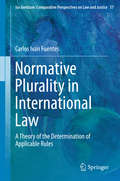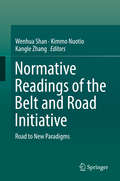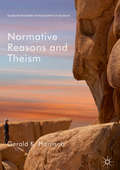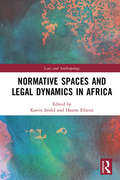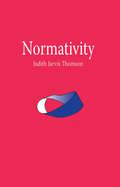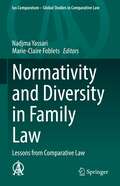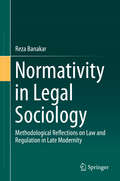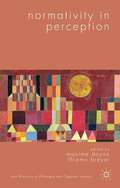- Table View
- List View
The Nonviolent God
by J. Denny WeaverThis bold new statement on the nonviolence of God challenges long-standing assumptions of divine violence in theology, the violent God pictured in the Old Testament, and the supposed violence of God in Revelation. In The Nonviolent God J. Denny Weaver argues that since God is revealed in Jesus, the nonviolence of Jesus most truly reflects the character of God.According to Weaver, the way Christians live -- Christian ethics -- is an ongoing expression of theology. Consequently, he suggests positive images of the reign of God made visible in the narrative of Jesus -- nonviolent practice, forgiveness and restorative justice, issues of racism and sexism, and more -- in order that Christians might live more peacefully.
Norco '80: The True Story of the Most Spectacular Bank Robbery in American History
by Peter Houlahan5 young men. 32 destroyed police vehicles. 1 spectacular bank robbery. This “cinematic” true crime story transports readers to the scene of one of the most shocking bank heists in U.S. history—a crime that’s almost too wild to be real (The New York Times Book Review).Norco ’80 tells the story of how five heavily armed young men—led by an apocalyptic born–again Christian—attempted a bank robbery that turned into one of the most violent criminal events in U.S. history, forever changing the face of American law enforcement. Part action thriller and part courtroom drama, this Edgar Award finalist for Best Fact Crime transports the reader back to the Southern California of the 1970s, an era of predatory evangelical gurus, doomsday predictions, megachurches, and soaring crime rates, with the threat of nuclear obliteration looming over it all.In this riveting true story, a group of landscapers transforms into a murderous gang of bank robbers armed to the teeth with military–grade weapons. Their desperate getaway turns the surrounding towns into war zones. And when it’s over, three are dead and close to twenty wounded; a police helicopter has been forced down from the sky, and thirty–two police vehicles have been completely demolished by thousands of rounds of ammo. The resulting trial shakes the community to the core, raising many issues that continue to plague society today: from the epidemic of post–traumatic stress disorder within law enforcement to religious extremism and the militarization of local police forces.
Nordic Criminal Justice in a Global Context: Practices and Promotion of Exceptionalism (Nordic Studies in a Global Context)
by Mikkel Jarle Christensen, Kjersti Lohne and Magnus HörnqvistThis book critically investigates Nordic criminal justice as a global role model. Not taking this role for granted, the chapters of the book analyse how Nordic approaches to criminal justice were folded into global contexts, and how patterns of promotion were built around perceptions that these approaches also had a particular value for other criminal justice systems. Specific actors, both internal and external to the region itself, have branded Nordic criminal justice as a form of ‘penal exceptionalism’ associated with human rights, universalistic welfare and social cohesion. The book shows how building and using the brand of Nordic criminal justice allowed stakeholders to champion specific forms of crime control across a variety of criminal justice areas in both domestic and international settings. The book will be of interest to scholars and students of criminal justice, international law and justice, Nordic and Scandinavian studies, and more widely to the social sciences and humanities.
Nordic Equality and Anti-Discrimination Laws in the Throes of Change: Legal developments in Sweden, Finland, Norway, and Iceland
by Anne Hellum, Ingunn Ikdahl, Vibeke Blaker Strand, and Eva-Maria SvenssonThe Nordic states were among the first in the world to enact general gender equality and anti-discrimination laws with low threshold enforcement mechanisms. Today, the Nordic countries top the World Economic Forum’s Gender Gap Index – but have still not succeeded in closing the gender gap. This book draws a diverse and complex picture of the long, uneven and unfinished process towards substantive equality in four Nordic countries: Sweden, Finland, Norway and Iceland. It presents the Nordic gender equality model’s systematic use of three measures: overarching gender policies, legislation that has an explicit or implicit impact on gender relations and gender equality and anti-discrimination laws with low threshold enforcement systems. What potentials and limitations does the Nordic gender equality and anti-discrimination law regimes have to combat individual discrimination and structural inequality? Can these regimes function as a driver of political, legal, economic, cultural and social change, and as a corrective to laws, policies and practices that uphold existing inequalities, and, if so, to what extent? Can weaknesses in the equality and anti-discrimination laws and the way they are enforced hamper efforts to close remaining gender gaps? Rather than looking at the Nordic gender equality laws and policies in isolation, the book situates their development and transformative potential within a changing European and international political and legal landscape.
Nordic Equality at a Crossroads: Feminist Legal Studies Coping with Difference (Routledge Revivals)
by Eva-Maria SvenssonOriginally published in 2004. Nordic Equality at a Crossroads makes a major contribution to the debates on equality and difference in contemporary Europe. In this absorbing work, feminist legal scholars from four Nordic countries provide a critical account of the latest legal policies in these countries linked with gender (in)equality, such as public financing of children's homecare, regulation of the labour market towards substantive equality, and the reforms concerning violence against women. These issues are matters of concern everywhere in Europe, and the solutions adopted in the Nordic countries will be of interest to all policy-makers. The increasing multiculturalism and the shift toward greater market orientation, however, have challenged the traditional Nordic equality policies. The authors argue that a structural and contextual analysis of inequality, also in the field of law, is necessary to encounter the challenge of pluralism.
Nordic Law in European Context (Ius Gentium: Comparative Perspectives on Law and Justice #73)
by Pia Letto-Vanamo Ditlev Tamm Bent Ole Gram MortensenNordic law is often referred to as something different from other legal systems. At the same time, it is a common belief that the Nordic countries share more or less the same legal tradition and are very similar in their approach to the law. Considering both of these points of view, the book tells a story of how Nordic law and Nordic legal thinking differ from other legal systems, and how there are many particularities in the law of each of the Nordic countries, making them different from each other.The idea of “Nordic” law also conceals national features. The basic premise of the book is that even if, strictly speaking, there is no such thing as a Nordic common law, it still makes sense to speak of “Nordic” law, and that acquiring a more-than-basic knowledge of this law is interesting not only for comparative lawyers, but also helpful for those working with Nordic lawyers and dealing with questions involving law in the Nordic countries.
Nordic Mediation Research
by Lin Adrian Kaijus Ervasti Anna NylundThis open access book presents twelve unique studies on mediation from researchers in Denmark, Finland, Norway and Sweden, respectively. Each study highlights important aspects of mediation, including the role of children in family mediation, the evolution and ambivalent application of restorative justice in the Nordic countries, the confusion of roles in court-connected mediation, and the challenges in dispute systems. Over the past 20-30 years, mediation has gained in popularity in many countries around the world and is often heralded as a suitable and cost-effective mode of conflict resolution. However, as the studies in this volumes show, mediation also has a number of potential drawbacks. Parties’ self-determination may be jeopardized, affected third parties are involved in an inadequate way, and the legal regulations may be flawed. The publication can inspire research, help professionals and policymakers in the field and be used as a textbook.
Norm Clusters of Non-State Armed Groups: Mapping and Understanding the Limits of Warfare as Understood by Non-State Armed Groups
by Will Jamison WrightThe proliferation of non-state armed groups and non-international armed conflicts since the end of the Second World War has challenged the legal frameworks which govern conduct in armed conflict. While aspects of international humanitarian law apply to such conflicts, international law can only go part of the way to explaining behaviour by armed groups. This book seeks to refocus discussion on the limits to armed conflict in such settings by examining the norms that underpin international humanitarian law as espoused by these armed groups to give a clearer picture as to the collectively constructed appropriateness of certain behaviours in or limits to warfare. The specific research question is “What are the norms of armed conflict as identified by non-state armed groups?” Using Winston’s norm cluster model, this study seeks to examine and map the ideations and behavioural prescriptions that constitute the armed conflict norm cluster as defined by non-state armed groups. To do this, it utilises a qualitative content analysis of documents from non-state armed groups coded to identify the different elements of this norm cluster as well as the frequency, pervasiveness, and connections between these elements. The findings showed that, while international humanitarian law is universal, these norms limiting armed conflict are not, with no norm being seen across all contexts examined. Core norms of international humanitarian law, especially those supported by norm entrepreneurs, were seen to be the focus of sub-clusters and the emergence of new parts of the norm cluster could be observed over time. The findings suggest that further work with the conceptualisation of limits to armed conflict as norms could be useful in improving the embeddedness of norms amongst non-state armed groups and could be useful in reconceptualising limits to armed conflict in cases where broadly accepted norms face growing contestation.
Norm Contestation, Sovereignty and: Debunking Liberal Anti-Politics (Norm Research in International Relations)
by Emanuela Piccolo KoskimiesGrappling specifically with the norm of sovereignty as responsibility, the book seeks to advance a critical constructivist understanding of norm development in international society, as opposed to the conventional – or liberal – constructivist (mis)understanding that still dominates the debate. Against this backdrop, the book delves into the institutionalization of sovereignty as responsibility within the lived practice of the International Criminal Court (ICC). More to the point, the proposed exploration intends to revive questions about the power-laden nature of the normative fabric of international society, its dis-symmetries, and its outright hierarchies, in order to devise an original framework to operationalize research on how – institutional – practice impinges on norm development. To this end, the book resorts to an original creole vocabulary, which combines the contributions of post-positivist constructivist scholars with the legacy of key post-modernist thinkers such as Michel Foucault and Jacques Derrida, as well as critical approaches to International (Criminal) Law and Post-Colonial Studies. The book will appeal to scholars of international relations and international law, in addition to critical scholars more broadly, as well as to practitioners in the fields of human rights and international justice interested in normative theory and the implementation and contestation of international social norms.
Normal at Any Cost
by Susan Cohen Christine CosgroveA fascinating story of medical experimentation, parental love, and the extreme measures taken to make children fit within ?the norm.? Most people rarely think about their height beyond a little wishing and hoping. But for the parents of children who are ridiculed by their peers for being extraordinarily tall or extraordinarily short, height can cause great anguish. For decades, the medical establishment has responded to these worries by prescribing controversial treatments and therapies for children who fall outside of the ?normal? height range. While some have benefited, many have suffered from devastating side effects. In this riveting book, Susan Cohen and Christine Cosgrove provide a voice for the parents, doctors, scientists, and pharmaceutical companies involved in these experimental treatments. They also tell the story of the boys and girls themselves, many of them now grown, who were subjected to a wide range of non-FDA-approved medical procedures. These treatments? which consisted of extreme doses of estrogen, pituitary glands taken from both animals and human cadavers, and testosterone injections?often had disastrous side effects. Who is to say how tall is too tall, and how short is too short? For many of the individuals represented in this book, the answers have been clear?and they are grateful to the medical industry for improving upon nature. For others, left in the wake of this same science, the answers are fueled by tragic regret. The authors explore the dueling motives behind these procedures? with parents desperate to help their children ?fit in? and doctors and scientists hungry for scientific breakthroughs. Combining extensive research and in-depth interviews, Normal at Any Cost is the first book to place a human face on this complex and ethically charged medical history.
Normal Life: Administrative Violence, Critical Trans Politics, and the Limits of Law
by Dean SpadeRevised and Expanded EditionWait--what's wrong with rights? It is usually assumed that trans and gender nonconforming people should follow the civil rights and "equality" strategies of lesbian and gay rights organizations by agitating for legal reforms that would ostensibly guarantee nondiscrimination and equal protection under the law. This approach assumes that the best way to address the poverty and criminalization that plague trans populations is to gain legal recognition and inclusion in the state's institutions. But is this strategy effective? In Normal Life Dean Spade presents revelatory critiques of the legal equality framework for social change, and points to examples of transformative grassroots trans activism that is raising demands that go beyond traditional civil rights reforms. Spade explodes assumptions about what legal rights can do for marginalized populations, and describes transformative resistance processes and formations that address the root causes of harm and violence. In the new afterword to this revised and expanded edition, Spade notes the rapid mainstreaming of trans politics and finds that his predictions that gaining legal recognition will fail to benefit trans populations are coming to fruition. Spade examines recent efforts by the Obama administration and trans equality advocates to "pinkwash" state violence by articulating the US military and prison systems as sites for trans inclusion reforms. In the context of recent increased mainstream visibility of trans people and trans politics, Spade continues to advocate for the dismantling of systems of state violence that shorten the lives of trans people. Now more than ever, Normal Life is an urgent call for justice and trans liberation, and the radical transformations it will require.
Normalizing Corruption: Failures of Accountability in Ukraine (Weiser Center for Emerging Democracies)
by Erik S. HerronAccountability is crucial to every successful democratic system. The failure to develop functioning mechanisms of accountability has undermined democratic consolidation worldwide. Reliable tools that hold officials accountable are essential for democratic governance; one of the key threats to accountability comes from corrupt practices, especially when they are integrated—or normalized—in the day-to-day activities of institutions. This book focuses on the experiences of contemporary Ukraine to evaluate the successes and failures of institutions, politicians, political parties, bureaucracies, and civil society. Yet, the topic is directly relevant to countries that have experienced democratic backsliding, and especially those countries that are at risk. Normalizing Corruption addresses several interconnected questions: Under what circumstances do incumbents lose elections? How well do party organizations encourage cohesive behavior? Is executive authority responsive to inquiries from public organizations and other government institutions? How can citizens influence government actions? Do civil servants conduct their duties as impartial professionals, or are they beholden to other interests? The research builds upon extensive fieldwork, data collection, and data analysis that Erik S. Herron has conducted since 1999.
Normative and Pragmatic Dimensions of Genetic Counseling
by Joseph B. FanningThis book provides an elaboration and evaluation of the dominant conceptions of genetic counseling as they are accounted for in three different models: the teaching model; the psychotherapeutic model; and the responsibility model. The elaboration of these models involves an identification of the larger traditions, visions and theories of communication that underwrite them; the evaluation entails an assessment of each model's theses and ultimately a comparison of their adequacy in response to two important concerns in genetic counseling: the contested values of non-directiveness and the recognition of differences across perspectives, with special focus on how religious and spiritual beliefs of patients are coordinated with the networks of meaning in genetics. Several insights are made explicit in this project through the work of Robert Brandom. Brandom's deontic scorekeeping model demonstrates how dialogue is at the root of grasping a conceptual content. Against this backdrop, professional communications such as genetic counseling can be seen as late developments in linguistic practices that have structural challenges. Brandom's model reminds us that the professional needs the client's understanding to grasp conceptual content in a particular context.
The Normative Force of the Factual: Legal Philosophy Between Is and Ought (Law and Philosophy Library #130)
by Nicoletta Bersier Ladavac Christoph Bezemek Frederick SchauerThis book explores the interrelation of facts and norms. How does law originate in the first place? What lies at the roots of this phenomenon? How is it preserved? And how does it come to an end? Questions like these led Georg Jellinek to speak of the “normative force of the factual” in the early 20th century, emphasizing the human tendency to infer rules from recurring events, and to perceive a certain practice not only as a fact but as a norm; a norm which not only allows us to distinguish regularity from irregularity, but at the same time, to treat deviances as transgressions. Today, Jellinek’s concept still provides astonishing insights on the dichotomy of “is” and “ought to be”, the emergence of the normative, the efficacy and the defeasibility of (legal) norms, and the distinct character of what legal theorists refer to as “normativity”. It leads us back to early legal history, it connects anthropology and legal theory, and it demonstrates the interdependence of law and the social sciences. In short: it invites us to fundamentally reassess the interrelation of facts and norms from various perspectives. The contributing authors to this volume have accepted that invitation.
Normative Pluralism and Human Rights: Social Normativities in Conflict (Juris Diversitas)
by Kyriaki TopidiThe complex legal situations arising from the coexistence of international law, state law, and social and religious norms in different parts of the world often include scenarios of conflict between them. These conflicting norms issued from different categories of ‘laws’ result in difficulties in describing, identifying and analysing human rights in plural environments. This volume studies how normative conflicts unfold when trapped in the aspirations of human rights and their local realizations. It reflects on how such tensions can be eased, while observing how and why they occur. The authors examine how obedience or resistance to the official law is generated through the interaction of a multiplicity of conflicting norms, interpretations and practices. Emphasis is placed on the actors involved in raising or decreasing the tension surrounding the conflict and the implications that the conflict carries, whether resolved or not, in conditions of asymmetric power movements. It is argued that legal responsiveness to state law depends on how people with different identities deal with it, narrate it and build expectations from it, bearing in mind that normative pluralism may also operate as an instrument towards the exclusion of certain communities from the public sphere. The chapters look particularly to expose the dialogue between parallel normative spheres in order for law to become more effective, while investigating the types of socio-legal variables that affect the functioning of law, leading to conflicts between rights, values and entire cultural frames.
Normative Pluralism and International Law
by Jan Klabbers Touko PiiparinenThis book addresses conflicts involving different normative orders: what happens when international law prohibits behavior, but the same behavior is nonetheless morally justified or warranted? Can the actor concerned ignore international law under appeal to morality? Can soldiers escape legal liability by pointing to honor? Can accountants do so under reference to professional standards? How, in other words, does law relate to other normative orders? The assumption behind this book is that law no longer automatically claims supremacy, but that actors can pick and choose which code to follow. The novelty resides not so much in identifying conflicts, but in exploring if, when and how different orders can be used intentionally. In doing so, the book covers conflicts between legal orders and conflicts involving law and honor, self-regulation, lex mercatoria, local social practices, bureaucracy, religion, professional standards and morality.
Normative Plurality in International Law
by Carlos Iván FuentesThis book provides a theoretical framework for explaining the choices made by international decision-makers in terms of what constitutes law. It comprehensively analyzes the practice of human rights courts in applying legal instruments outside their competence and proposes that this practice recognizes that different normative instruments coexist in an un-ordered space, and that meaning can be produced by the free interaction of those instruments around a problem. Based on this, the book advances its normative plurality hypothesis, which states that decision-makers must survey the acquis of international law in order to identify all the instruments containing relevant normative information for a particular situation. The set of rules of law applicable to the situation must then be complemented with other instruments containing specific normative information relevant to the situation, resulting in a complete system of norms advancing a common purpose.
Normative Readings of the Belt and Road Initiative: Road To New Paradigms
by Wenhua Shan Kimmo Nuotio Kangle ZhangThis timely book offers revealing insights into the changing role of China in world governance as exemplified by the Silk Road Initiative, the People’s Republic’s first published major initiative for external affairs. Focusing on various aspects of the Silk Road Initiative, particularly those that are largely neglected in current discussions, including culture and philosophy, finance and investment, environmental protection and social responsibility, judiciary and lawyers, the authors explore a wide range of contexts in which China’s role as an emerging power in international relations and international law is examined. In the current era of ever-increasing populism, protectionism and challenges to globalization, the authors explore the Chinese philosophy underpinning Chinese norms of regional and international development. Bearing in mind the political and economic uncertainties hampering the establishment of such norms, the authors offer crucial insights into how the Silk Road Initiative could or should be developed and regulated.Given its depth of coverage, the book is an indispensable read for anyone interested in the Initiative and its social-legal implications.
Normative Reasons and Theism (Palgrave Frontiers in Philosophy of Religion)
by Gerald K. HarrisonNormative reasons are reasons to do and believe things. Intellectual inquiry seems to presuppose their existence, for we cannot justifiably conclude that we exist; that there is an external world; and that there are better and worse ways of investigating it and behaving in it, unless there are reasons to do and believe such things. But just what in the world are normative reasons? In this book a case is made for believing normative reasons are favouring relations that have a single, external source, filling this significant gap in the literature in an area within contemporary philosophy that has quickly grown in prominence. Providing a divine command metanormative analysis of normative reasons on entirely non-religious grounds, its arguments will be relevant to both secular and non-secular audiences alike and will address key issues in meta-ethics, evolutionary theory - especially evolutionary debunking threats to moral reasons and the normative more generally - and epistemology.
Normative Spaces and Legal Dynamics in Africa (Law and Anthropology)
by Katrin Seidel Hatem ElliesieAfrican legal realities reflect an intertwining of transnational, regional, and local normative frameworks, institutions, and practices that challenge the idea of the sovereign territorial state. This book analyses the novel constellations of governance actors and conditions under which they interact and compete. The work follows a spatial approach as the emphasis on normative spaces opens avenues to better understand power relations, processes of institutionalization, and the production of legitimacy and normativities themselves. Selected case studies from thirteen African countries deliver new empirical data and grounded insights from, and into, particular normative spaces. The individual chapters explore the interrelationships between various normative orders, diverse actors, and their influences. The encounters between different normative understandings and actors open up space and multiple forums for negotiating values. The authors analyse how different doctrines, institutions, and practices are constructed, contested, negotiated, and adapted in translation processes and thereby continuously reshape Africa’s multidimensional normative spaces. The volume delivers nuanced views of jurisprudence in Africa and presents an excellent resource for scholars and students of anthropology, legal geography, legal studies, sociology, political sciences, international relations, African studies, and anyone wishing to gain a better understanding of how legal constellations are shaped by unreflected assumptions about the state and the rule of law.
Normativity
by Judith Jarvis ThomsonJudith Jarvis Thomson's Normativity is a study of normative thought. She brings out that normative thought is not restricted to moral thought. <P><P>Normative judgments divide into two sub-kinds, the evaluative and the directive; but the sub-kinds are larger than is commonly appreciated. Evaluative judgments include the judgments that such and such is a good umbrella, that Alfred is a witty comedian, and that Bert answered Carol's question correctly, as well as the judgment that David is a good human being. Directive judgments include the judgment that a toaster should toast evenly, that Edward ought to get a haircut, and that Frances must move her rook, as well as the judgment that George ought to be kind to his little brother. Thomson describes how judgments of these two sub-kinds interconnect and what makes them true when they are true. Given the extensiveness of the two sub-kinds of normative judgment, our everyday thinking is rich in normativity, and moreover, there is no gap between normative and factual thought. The widespread suspicion of the normative is therefore in large measure due to nothing deeper than an excessively narrow conception of what counts as a normative judgment.
Normativity and Diversity in Family Law: Lessons from Comparative Law (Ius Comparatum - Global Studies in Comparative Law #57)
by Nadjma Yassari Marie-Claire FobletsWith regard to family law, this volume examines claims based on cultural tradition, ethnic background, custom, religious affiliation and sexual orientation, as well as various other “claims” that are not officially recognized in state law, in 15 jurisdictions around the world. The country reports seek to determine whether these claims represent a challenge to family law as conceived by the state, and if so, how these challenges are being managed. The focus lies on the interaction between (i) claims and traditions raising minority-related and diversity-related issues and (ii) the state as the addressee of these demands for accommodation. The reports identify specific instances and situations that have proven (and in many cases still are) particularly difficult to resolve. They force decision-makers to engage in a delicate balancing act between different, often clashing interests.
Normativity and Phenomenology in Husserl and Heidegger
by Steven CrowellSteven Crowell has been for many years a leading voice in debates on twentieth-century European philosophy. This volume presents thirteen recent essays that together provide a systematic account of the relation between meaningful experience (intentionality) and responsiveness to norms. They argue for a new understanding of the philosophical importance of phenomenology, taking the work of Husserl and Heidegger as exemplary, and introducing a conception of phenomenology broad enough to encompass the practices of both philosophers. Crowell discusses Husserl's analyses of first-person authority, the semantics of conscious experience, the structure of perceptual content, and the embodied subject, and shows how Heidegger's interpretation of the self addresses problems in Husserl's approach to the normative structure of meaning. His volume will be valuable for upper-level students and scholars interested in phenomenological approaches to philosophical questions in both the European and the analytic traditions.
Normativity in Legal Sociology
by Reza BanakarThe field of socio-legal research has encountered three fundamental challenges over the last three decades - it has been criticized for paying insufficient attention to legal doctrine, for failing to develop a sound theoretical foundation and for not keeping pace with the effects of the increasing globalization and internationalization of law, state and society. This book examines these three challenges from a methodological standpoint. It addresses the first two by demonstrating that legal sociology has much to say about justice as a kind of social experience and has always engaged theoretically with forms of normativity, albeit on its own empirical terms rather than on legal theory's analytical terms. The book then explores the third challenge, a result of the changing nature of society, by highlighting the move from the industrial relations of early modernity to the post-industrial conditions of late modernity, an age dominated by information technology. It poses the question whether socio-legal research has sufficiently reassessed its own theoretical premises regarding the relationship between law, state and society, so as to grasp the new social and cultural forms of organization specific to the twenty-first century's global societies.
Normativity in Perception (New Directions In Philosophy And Cognitive Science)
by Thiemo Breyer Maxime DoyonNormativity in Perception.
